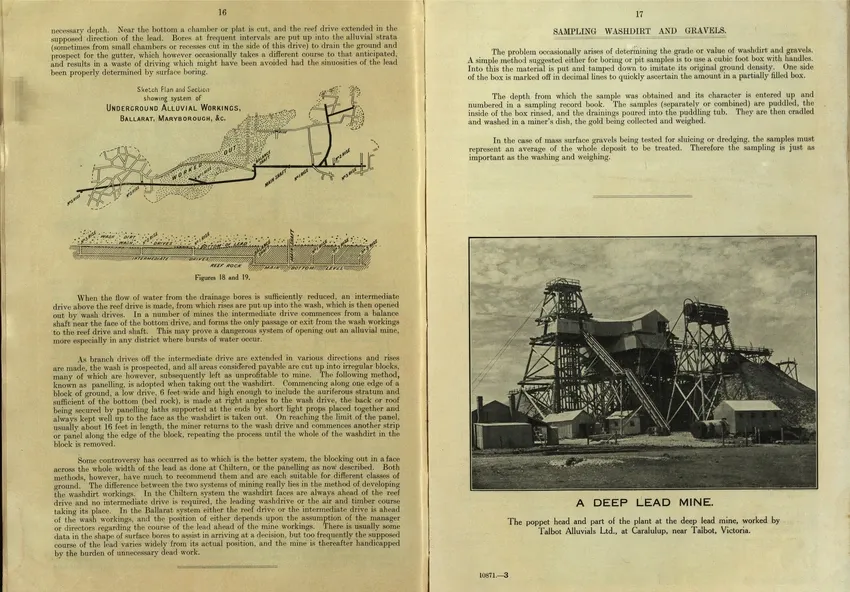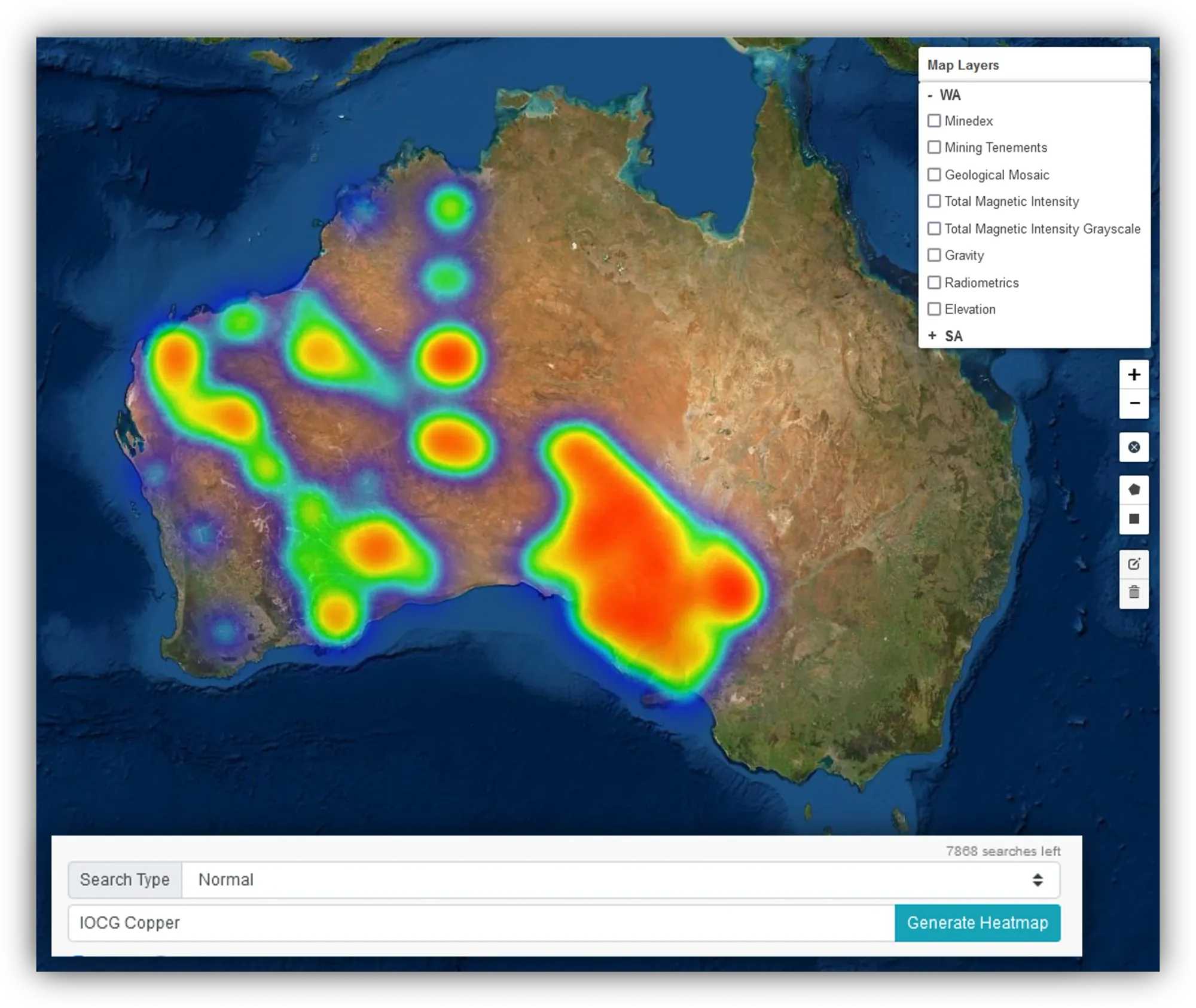Revolutionizing Geological and Mining Data Search: How RadiXplore Uses AI to Extract Meaningful Insights from Unstructured Text
Explore how RadiXplore’s Hybrid Extractive Search enhances geological data analysis. Combining keyword precision with AI semantic understanding, we replicate six key geologist skills to revolutionize mining data discovery and exploration. Discover the future of data search!

In the world of geological and mining data analysis, extracting valuable insights from unstructured text can be challenging. RadiXplore is transforming this process with our Hybrid Extractive Search, which combines keyword precision with semantic understanding to mimic geologist reading abilities. This technology emulates six crucial skills of a geoscientist, blending traditional search accuracy with advanced AI comprehension. Discover how RadiXplore’s innovative approach enhances data discovery and exploration, making it easier to unlock insights from complex datasets.
Ability 1 - Meaningful Contextual Search
When searching for information, it's often hard to predict the exact wording an author might have used in their report. That's why our search feature is designed to think more like you. It intelligently identifies variations and forms of the words related to your search query. For example, if you search for "hematization," our system also surfaces results that include "hematizing," "hematized," "hematisation," and more. This ensures you receive highly relevant results without needing to guess the specific phrasing used by the author. It’s like having a personal geological assistant who understands your intent and finds precisely what you need.
RadiXplore leverages advanced natural language processing (NLP) and information retrieval techniques to deliver contextually accurate results. Instead of merely matching synonyms, it focuses on the semantic intent behind your query by analyzing its lexical and syntactical structure. This allows the system to grasp the underlying concepts and entities and expand the search to include all related forms of a word.
In tests, this approach produced up to 7 times more relevant results than standard keyword-based search systems.
Ability 2 - Uncover Hidden Connections with Semantic Discovery Using RadixSuggest
Ever wondered what words are related to the ones you're searching for? Our Semantic Discovery feature helps you find those connections effortlessly. When you enter a word, it reveals a list of terms that are closely related, such as:
- Synonyms: Words with the same or similar meanings.
- Related Concepts: Words that are associated with the original term.
Think of it as a map that shows hidden relationships between words, enabling you to discover new connections and ideas you might not have considered. For example, if you search for "IOCG," Semantic Discovery might suggest terms like "Olympic," "Gravity," "Copper," and "Gawler"—all of which are connected to IOCG in some way. If you're curious about the link between "Olympic" and "IOCG," searching them together could lead you to information about the Olympic Dam, a well-known IOCG deposit.
With Semantic Discovery, you can:
- Expand Your Search: Include related concepts to get a broader view.
- Deepen Understanding: Gain insights into the topic you're researching.
- Discover New Terms: Find concepts and relationships you might not have known otherwise.
This feature acts like a personal research assistant that reveals the hidden connections in language, helping you explore beyond the obvious.
Semantic Discovery leverages the inherent structure of language to identify and surface related terms, concepts, and entities within a dataset. Unlike traditional methods that depend on machine learning models or predefined ontologies, our approach uses a data-driven, rule-based system to discover semantic relationships.
Key Advantages:
- Flexibility: Works with any dataset without needing model retraining or domain adaptation.
- Interpretability: Offers clear, rule-based results rather than opaque model predictions.
- Efficiency: Scalable and computationally efficient, without relying on resource-intensive machine learning models.
By harnessing the structure of language itself, Semantic Discovery provides a robust tool for uncovering meaningful connections—ideal for applications ranging from search and discovery to text analysis and knowledge graph construction.
Ability 3 - Advanced AI for Poor-Quality Documents
When you search for something, you expect the results to match what you typed. But what happens when the text contains spelling errors, OCR mistakes, or poor handwriting? That's where our advanced AI-powered search technology comes into play.
RadiXplore mimics the way the human brain recognizes words—not by examining each individual letter, but by understanding the overall shape and pattern of the word. This enables us to identify the correct word even when it is misspelled or distorted. Think of it like recognizing a friend's face: you don't focus on each individual feature, but rather the overall pattern that defines them. Similarly, our search system identifies the general shape and structure of words rather than each letter.
For instance, if you search for "Hematisation," our algorithm can find results for "Haematisation," "Hematitization," "Hematised," "Hemisification," and other related variations by recognizing the overall pattern of the word.
Our fuzzy search algorithm combines natural language processing (NLP) and fuzzy string matching techniques to accurately match search terms to text, even when there are errors or variations. It does this by:
- Breaking down words into shapes and patterns.
- Comparing these patterns to the search term
- Returning results that match the overall pattern, even when there are spelling mistakes or OCR errors.
Key Features of Our Approach:
- Fuzzy Matching Techniques: Utilizes fuzzy edit distance and Jaccard similarity measures to calculate the equivalence between search terms and text data, allowing for flexible and tolerant matching.
- Highly Scalable: Capable of processing tens of billions of words in mere seconds, making it ideal for large-scale text search applications where speed and accuracy are crucial.
- Effective with Imperfect Text: Provides relevant results even when the input text contains minor errors or inconsistencies.
By leveraging this smart search technology, we help you find what you're looking for, even when the documents are imperfect or contain errors. It's like having an intelligent assistant that navigates through messy text to deliver the most relevant information to you.
Ability 4 - Flexible Phrase Matching with Sloppy Phrases
Humans have an innate ability to recognize flexible patterns in language. When recalling phrases or sentences, we often remember the general meaning and structure rather than the exact wording. This allows us to recognize similar phrases even if they are not identical. Our Sloppy Phrase feature mimics this human capability, enabling users to find phrases that match the overall pattern and meaning of their search query without needing an exact match.
This approach aligns with how humans use semantic memory—recalling concepts and patterns instead of precise details. It makes search more intuitive and adaptable, replicating the natural way we think and remember language.
For example, when searching for "massive nickel sulphide," the sloppy phrase search can identify variations like:
- "Nickel sulphides and massive sulphides"
- "Disseminated sulphides are commonly located above and in contact with the massive sulphide"
By allowing for slight variations and positioning differences, our sloppy phrase search provides over 50% more results compared to a traditional phrase search.
Key Features of Our Approach:
- Flexible Pattern Recognition: Captures relevant content even when the phrasing differs slightly from the query.
- Enhanced Recall: Emulates the human ability to understand the general context rather than requiring an exact match.
- Improved Search Results: Increases the number of relevant results, making it easier to find the information you need.
By incorporating this flexible approach to phrase searching, we offer a powerful tool that aligns more closely with how humans process and recall language, making search more forgiving and effective.
Ability 5 - Assay Finder - Intelligent Range and Contextual Search for Assay Data
Searching for specific numerical ranges within text can be a challenge, especially when dealing with complex data like mineral assays. Traditional search systems struggle to locate ranges embedded within text, such as "40-50 g/t Au," because they treat these numbers as exact strings rather than understanding them as a numeric range. Our Intelligent Range and Contextual Search feature overcomes this limitation, providing a powerful tool to search not just for numbers, but for numbers in context.
Our advanced search technology is capable of identifying numeric ranges within textual data, even when they are embedded in natural language or technical jargon. For example, if you're looking for mineral assays within a specific range, such as "40-50 g/t Au" for gold, our system can find all instances that fall within that range, regardless of how the numbers are formatted or presented in the text.

Flexible Contextual Search:
But it doesn’t stop there. Our search also allows you to combine numeric range searches with specific text criteria to pinpoint exactly what you need. If you're interested in assay data specifically mentioning "quartz veins," you can search for assays within a specific range and reference to "quartz veins" in the same document. The search engine will intelligently find all relevant entries, like:
- "Quartz veins contain 45 g/t Au"
- "Gold values between 42-48 g/t found in quartz veins"
- "40-50 g/t Au observed in altered quartz veins"
This dual capability of searching for numeric ranges alongside contextual text makes our system exceptionally powerful for geological research and exploration, where precision is crucial.
Key Benefits:
- Numeric Range Detection: Finds numbers within a specified range, even if they are part of natural text or images, overcoming the limitations of traditional string-based searches.
- Contextual Relevance: Combines numeric range searches with specific keywords or phrases to ensure results are highly relevant and targeted.
- Enhanced Flexibility: Allows for complex searches that would typically require multiple steps, providing a seamless and efficient user experience.
- Improved Discovery: Maximizes the likelihood of finding all relevant documents by searching both numeric data and associated geological contexts.
With this intelligent search ability, users can perform more refined searches that combine numerical precision with geological context, making it an invaluable tool for professionals in mining, geology, and exploration.
Ability 6 - Advanced Geospatial Analysis and Visualization
All our documents are meticulously geotagged, allowing every search result to be visualized on a geospatial map. This capability not only shows where relevant information is located geographically, but also provides insights into how "hot" or concentrated certain results are over specific areas. By combining this geospatial visualization with the other advanced search abilities, we can bridge the gap between unstructured text data and structured geospatial datasets, revealing patterns that were previously hidden.
Our Advanced Geospatial Analysis feature enables users to take advantage of geotagged documents to visualize search results in a meaningful spatial context. When you perform a search, whether it’s for mineral occurrences, assay values, or specific geological features like "quartz veins" or "IOCG deposits," the results can be displayed on a heat map that highlights the density and relevance of findings across a geographic area.
This spatial heatmap shows the intensity of relevant data points, allowing users to quickly identify "hotspots" where specific minerals, geological features, or exploration opportunities are concentrated. The visualization is dynamically generated by leveraging the insights gained from Abilities 1 to 5, such as meaningful contextual searches, flexible phrase matching, and range-based filtering.

Integration with GIS Layers:
But the power of our geospatial analysis doesn't stop there. By integrating this heat map with other GIS layers—such as potential field data, geological maps, and geochemistry layers—users can correlate text-derived insights with other spatial datasets. This integration creates a comprehensive view of the exploration landscape, where the combination of unstructured text data and structured geospatial data can uncover previously unseen patterns and relationships. For example:
- Potential Field Data: Correlate areas of high relevance with magnetic or gravity anomalies to identify regions with exploration potential.
- Geological Layers: Overlay relevant search results on geological maps to understand the geological context of mineral occurrences.
- Geochemical Layers: Combine assay data and mineral search results with geochemical data to refine exploration targets.
Key Benefits:
- Spatial Relevance Visualization: Shows the distribution and intensity of relevant search results on a map, providing immediate visual insights into potential areas of interest.
- Multidimensional Data Integration: Integrates unstructured text data with structured spatial datasets, offering a holistic view of the geological landscape.
- Enhanced Exploration Targeting: By revealing hidden correlations between text-based information and geospatial data, users can uncover new exploration opportunities and refine their search for mineral deposits.
- Actionable Insights: Provides a powerful tool for geoscientists and exploration professionals to make more informed decisions by visualizing complex data in an intuitive, map-based format.
By combining our advanced text search capabilities with geospatial analysis, we are revolutionizing the way unstructured information is utilized in exploration. This ability transforms how geoscientists can search, visualize, and interpret vast amounts of unstructured text data alongside traditional geospatial datasets, opening the door to discoveries that were previously impossible.
Conclusion
In today’s data-driven world, the ability to extract meaningful insights from vast amounts of unstructured text is a game-changer, especially in industries like mining and geology. RadiXplore's advanced search capabilities—from meaningful contextual search and intelligent range detection to geospatial visualization—are transforming how geoscientists and exploration professionals interact with data. By mimicking the way humans think, interpret, and recall information, our system bridges the gap between traditional data silos and modern, intuitive data discovery.
Whether you’re searching for mineral assays, exploring potential exploration hotspots, or uncovering hidden patterns in historical reports, RadiXplore provides the tools to make data-driven decisions faster and more accurately. Our hybrid extractive search combines the precision of keyword searches with the semantic understanding of vector searches, delivering unmatched results that feel like having a personal geological assistant by your side.
Ready to see the difference for yourself? Sign up for a free demo today and discover how RadiXplore can revolutionize your data exploration and analysis workflows. Or, if you have any questions, feel free to get in touch with us—our team is here to help you unlock the full potential of your unstructured data.
Don’t miss the opportunity to transform your approach to data discovery. Contact us now!

